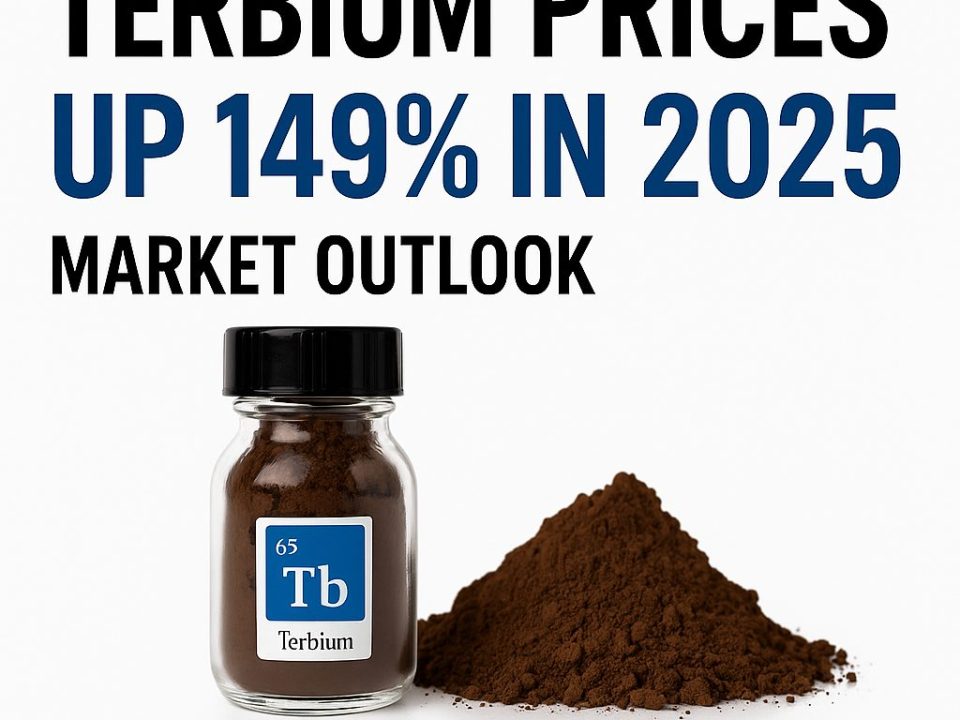
Press Release: Strategic Metals Invest Highlights Growing Importance of Rare Earths as Physical Assets Following Trump–Xi Trade Truce
November 2, 2025
Neodymium Prices Surge in 2025: What’s Driving the Rare Earth Revival?
November 13, 2025The rare earth cat-and-mouse game between China and the United States dominated the headlines this week. While the U.S. announced a widespread easing of export curbs, Beijing was relatively quiet. Meanwhile, the People’s Republic published the first batch of October trade data.
CHINA SUSPENDS SOME RARE EARTH CURBS TO THE US:
According to a fact sheet, Beijing will issue “General Licenses.”
China will suspend new export restrictions on rare-earth metals and ease curbs on other critical minerals, according to a White House fact sheet detailing agreements reached between President Donald Trump and Chinese President Xi Jinping.
Released on Saturday, the fact sheet states that Beijing will issue “general licenses” for the exports of rare earths, gallium, germanium, antimony, and graphite, to benefit U.S. end consumers and their suppliers, which would, according to the White House, effectively lift controls imposed in April 2025 and October 2022.
Which October 2022 measure is referenced is unclear, as China had not issued corresponding rules at the time. In contrast, Beijing tightened export regulations for rare-earth elements in October 2025. The fact sheet does not mention other recent restrictions, including those on indium, tungsten, and molybdenum from February 2025 or earlier controls on gallium and germanium, which were initially imposed in August 2023.
General licenses allow approved companies to export these materials repeatedly without seeking individual approval for each shipment.
White House Fact Sheet Goes Beyond MOFCOM’s Version:
The U.S. statement goes beyond what China’s Ministry of Commerce announced last week, when it said only that the October 9 tightening of export controls would be suspended for one year. Washington’s version outlines broader measures, including longer-term export permissions and the termination of investigations into U.S. semiconductor companies.
U.S. Treasury Secretary Scott Bessent said the deal “buys time” for both sides but cautioned that reliance on Chinese rare-earth supply remains risky. “The Chinese have cornered the market, and at times, they’ve proved unreliable partners,” he told Fox News Sunday, adding that the U.S. would respond if China backtracks on the agreement.
China has not yet published its own version of the agreement, leaving questions about implementation and the full scope of the deal. Additionally, it remains unclear whether the general licenses apply solely to U.S. companies or also extend to companies in other countries.
AUSTRALIA AND CANADA DEEPEN PARTNERSHIP ON RARE EARTHS:
Joint declaration signed at the sidelines of the G7 Energy and Environment Ministers’ Meeting in Toronto.
Australia and Canada are set to strengthen their collaboration in the critical minerals sector. On Saturday, at the G7 Energy and Environment Ministers’ Meeting in Toronto, Australian Resources Minister Madeleine King and Canada’s Minister for Energy and Natural Resources Tim Hodgson formally signed a Joint Declaration of Intent on Critical Minerals Collaboration.
The objectives of the partnership are to foster a deeper partnership in critical minerals, particularly by linking upstream production with midstream technologies to mutually benefit each other’s economies. In addition, the agreement establishes a framework for ministerial-level meetings, special envoys, and formal cooperation plans.
Both nations are major global producers of critical minerals, holding substantial reserves of lithium, rare earth elements, nickel, and other strategic resources. In addition, the declaration emphasizes Australia’s geological advantages and mining expertise, complementing Canada’s advanced processing infrastructure and proximity to major North American markets.
In recent months, both Canada and Australia have intensified their efforts to maximize the benefits of their natural resources by forming international partnerships. Through these collaborations, they aim to position themselves as viable alternatives to industry leader China. For example, Canada signed an agreement with Germany in August, while Australia reached a deal with the United States just last month.
INDIA TO TRIPLE SUBSIDIES FOR DOMESTIC SUPPLY OF RARE EARTH MAGNETS:
According to media reports, India is planning a significant increase to its subsidy program for rare-earth magnets, initially announced only in July.
Earlier this year, India unveiled plans to boost domestic production of rare-earth magnets. Now, the subsidies earmarked for the program are reportedly set to rise sharply, from the original $290 million to $788 million, Bloomberg reports, citing sources familiar with the matter.
Several companies are expected to benefit through a combination of production-linked and investment incentives. The proposal still requires cabinet approval, and the final amount could change. Additionally, the Indian government plans to fund research to optimize electric motors without relying on rare earths, a move that could ultimately reduce long-term raw material demand.
The subsidy program reflects India’s strategic goal of reducing its dependence on the rare-earth giant, China, while simultaneously strengthening its own high-tech sector. In April, China imposed strict export restrictions on several rare-earth elements, which significantly impacted India’s emerging electric vehicle industry. In October, the export regulations were tightened even further. Although implementation has recently been postponed for one year, India and other countries continue to push forward with developing their own supply chains in response to China’s clear demonstration of market dominance.
However, building domestic capacity remains challenging. Technological know-how is concentrated mainly in China, while long lead times and limited investment present additional obstacles, particularly for new mining projects. To improve the economic viability of these initiatives, countries, including India and the United States, are increasingly subsidizing their domestic critical minerals sectors.
NOVEON USA TO PRODUCE RARE EARTH MAGNETS IN THE USA:
Operations are expected to begin in 2027 with an annual capacity of up to 2,000 tons.
U.S.-based Noveon Magnetics, a manufacturer of sintered rare-earth magnets, has announced plans to build a production facility in South Korea. The project will be developed in partnership with South Korean engineering firm Kangwon Energy, with a memorandum of understanding signed on Monday.
Production is scheduled to begin in 2027, with an anticipated annual capacity of up to 2,000 tons of sintered NdFeB rare-earth permanent magnets. In addition to magnet manufacturing, the facility will focus on recycling technologies.
According to both companies, the initiative is driven by growing global demand for rare-earth magnets produced outside China. Currently, more than 90 percent of these high-tech components originate from China, which also dominates the mining and refining of the necessary raw materials. Amid rising geopolitical tensions and increasing supply risks, Western nations are seeking to diversify their sources of critical minerals.
Several partnerships between U.S. and South Korean companies have already been established as part of this effort. U.S. rare-earth producer Energy Fuels, for example, supplies materials to the electric mobility division of South Korean conglomerate Posco.
ReElement Technologies, a subsidiary of American Resources Corporation, is also working with Posco. Noveon itself has been active in South Korea’s value chain since May 2023, when it signed an agreement with Australian Strategic Materials to source rare-earth materials from the company’s processing facility in the country.
UNITED STATES MOVES TO STRENGTHEN DOMESTIC RARE EARTH SUPPLY CHAIN:
The U.S. government is reaffirming its commitment to expanding national capabilities in the extraction and processing of critical raw materials. The Department of Commerce plans to acquire a $50 million stake in Vulcan Elements. The North Carolina-based manufacturer of rare-earth magnets will use the funds to acquire equipment to produce these vital components, according to a press release from the department. The agreement is still preliminary.
Meanwhile, the Department of Defense will provide $620 million in loans to expand production capacity through the construction of a new factory, supplemented by $550 million in private capital. The company’s press release states that the planned annual production capacity will reach 10,000 tons.
Vulcan Elements is working closely with its partner, ReElement Technologies, to develop the entire value chain from mine to magnet. ReElement, based in Indiana, operates a rare earth refinery capable of processing both ores and recycled materials. To expand its production, ReElement will receive $80 million from the Office of Strategic Capital, an affiliated entity of the U.S. Department of Defense, matched by an equal amount of private capital.
CANADA: RIO TINTO INVESTS TO EXPAND SCANDIUM PRODUCTION –
Mining giant Rio Tinto has secured an investment of roughly $18 million (C$25 million) from the Canada Growth Fund (CGF) to scale up scandium oxide production at its Sorel-Tracy facility in Quebec. The investment is part of Canada’s new Critical Minerals Production Alliance (CMPA), unveiled by Energy and Natural Resources Minister Tim Hodgson, which unlocks 26 projects worth roughly $4.6 billion in partnership with nine allied nations, including the United States, Australia, and Germany.
Scandium is prized for its ability to strengthen aluminum alloys used in aircraft and defense applications, as well as for its role in solid oxide fuel cells. Rio Tinto’s process extracts scandium from titanium dioxide waste, reducing the need for new mining and minimizing environmental impact, the company said. Under the deal, the Government of Canada will purchase a volume of scandium through an offtake agreement and work with Rio Tinto on marketing and storage.
In 2022, Rio Tinto became the first North American producer of scandium oxide and has since scaled up production. The United States recently added the element to its national stockpile and plans to source material from Rio Tinto’s operation.
The announcement of the Canada Growth Fund’s investment was made at the G7 Energy and Environment Ministers’ Meeting in Toronto, where Minister Hogson also signed a new Canada–Australia Joint Declaration on Critical Minerals Collaboration alongside Australian Resources Minister Madeleine King. The pact links Australia’s upstream mining expertise with Canada’s advanced processing capacity and North American market access.
CANADA: ANOTHER PARTNERSHIP TO STRENGTHEN WESTERN RARE EARTH SUPPLY CHAINS:
In a further step to diversify rare earth supply chains beyond China, Canadian refining and technology company Ucore Rare Metals has announced a partnership with German magnet manufacturer Vacuumschmelze (VAC). Under the agreement, Ucore will supply VAC’s production facilities in Europe and the U.S. with separated rare earth oxides, including neodymium, praseodymium, terbium, dysprosium, samarium, and gadolinium. The latter four elements are of particular strategic importance, as China imposed strict export controls on them in April 2025, restrictions that have already led to temporary supply shortages.
VAC, with support from the U.S. Department of Defense, has built a new manufacturing facility in South Carolina, scheduled to begin operations later this fall. Ucore’s materials will initially be refined at its demonstration plant in Kingston, Canada, before being processed at a planned commercial refinery in Louisiana, expected to start operations in the second half of 2026 (PDF). This U.S. facility has also received funding from the Pentagon. Ucore uses its proprietary RapidSX technology for the separation and purification of rare-earth elements. The Canadian government has recently announced additional funding for a new demonstration plant in Kingston dedicated to the production of samarium and gadolinium.
Both companies are already deeply involved in building independent rare-earth supply chains. For example, they both collaborate with Cyclic Materials, a Canadian recycler of critical raw materials, and have expressed interest in sourcing rare earths from South America.
EU PUSHES FOR FASTER EXPORT APPROVALS OF RARE EARTHS:
The European Union is seeking to secure supplies of rare earths and related materials for its industries by establishing a new communication channel with Chinese authorities. According to EU Trade Commissioner Maroš Šefčovič, this mechanism is intended to expedite the export licensing process that has been required since April.
At the same time, the EU is working toward an agreement on so-called general licenses that would allow companies to export materials repeatedly without having to apply for individual permits for each shipment.
The initiative draws inspiration from a similar measure unilaterally announced by the United States, which is intended to benefit U.S. end users and their suppliers. However, China has yet to confirm whether it will approve the U.S. framework or reverse the export controls on rare earths introduced in April. Those controls were part of China’s response to U.S. tariffs announced the same month, but they have since raised concerns about supply shortages across global industries.
JAPAN AND THE US DISCUSS JOINT DEEP SEA MINING PROJECT:
Japan has been planning to mine rare earth elements around the Pacific island of Minamitorishima for several years, and the United States may now join the effort following the recent conclusion of a bilateral minerals agreement.
Last week, Japan and the U.S. agreed to deepen cooperation on critical minerals (we reported). As part of that framework, the two nations also intend to work together on deep-sea resource extraction, Reuters reports.
Specifically, joint exploration of rare earth deposits in waters surrounding the Pacific island of Minamitorishima is under consideration, Japanese Prime Minister Sanae Takaichi told parliament on Thursday. Japan has been pursuing plans to extract critical minerals from this area for several years as part of its strategy to reduce dependence on Chinese imports. The site, located roughly 1,900 kilometers southeast of Tokyo, lies within Japan’s exclusive economic zone.
According to Takaichi, deep-sea mud in the region is believed to contain rare earth elements. Test mining from a depth of about 6,000 meters is scheduled to begin in January 2026. If successful, Japan plans to trial a system the following year capable of extracting around 350 tons of sediment per day.
CHINA’S RARE EARTH EXPORTS EDGE HIGHER IN OCTOBER AFTER MONTHS IN DECLINE:
China’s rare earth exports rose slightly in October for the first time since June, signaling a tentative stabilization after several months of declining shipments.
Data from the General Administration of Customs showed that China exported 4,345.5 metric tons of rare earths in October, up 8.7% from 4,000 tons in September. The world’s leading supplier of minerals critical for electric vehicles, wind turbines, and advanced electronics had seen exports fall sharply through the summer, following the introduction of expanded export controls in April.
In early October, Beijing announced a new round of controls covering five additional rare earth elements and dozens of refining technologies, tightening its grip on the strategically important sector. Some of these rules were slated to take effect in early November, raising concerns over further supply disruptions. However, following a high-level meeting between U.S. President Donald Trump and Chinese President Xi Jinping in Busan on October 30, China announced that it would pause the new export measures for one year. The White House separately announced what it described as a broader easing of restrictions, though Beijing has yet to confirm any such move.
For the first ten months of 2025, China’s rare earth exports totaled about 52,700 tons, up 10.5% from the same period in 2024, according to customs data.
Analysts caution that the October uptick likely reflects a temporary stabilization rather than a sustained recovery, Reuters reports. “The pause in controls provides short-term relief,” one industry analyst said, “but China’s long-term strategy of tightening oversight on rare earth exports remains unchanged.”
USA: PENTAGONS INVESTMENT IN MP MATERIALS INITIALLY WEIGHS ON REVENUE:
MP Materials reported a drop in revenue in the third quarter, citing the impact of its new partnership with the U.S. Department of Defense (DoD). As part of the agreement reached this summer, the leading U.S. rare-earth producer committed to halting exports of rare-earth products to China. The Las Vegas–based company reported a 15% year-over-year decline in revenue, resulting in a wider net loss for the quarter. MP Materials had already suspended exports to China in April due to high tariffs.
Despite the revenue decline, the company reported positive developments in sales of magnetic precursors and neodymium-praseodymium (NdPr), as production of separated rare earths increased. Under the DoD agreement, the Pentagon guarantees a minimum price for neodymium and praseodymium —the company’s two most important products —effective October 1, according to remarks during a conference call on quarterly results, Reuters reported.
MP Materials CEO James Litinsky emphasized the importance of government investment in strategic industries, saying control over critical materials, advanced technologies, and the supply chains that support them has become a decisive measure of national power.
UNITED STATES GEOLOGICAL SERVICE ADDS 10 NEW RARE MATERIALS TO 2025 CRITICAL MINERALS LIST:
Copper, silver, rhenium, and silicon are now among those deemed vital to the U.S. economy and national security.
The U.S. Geological Survey (USGS) has released its updated list of critical minerals for 2025, identifying materials considered essential to the U.S. economy and national security, as well as vulnerable to supply chain disruptions.
Compared with the 2022 list, 10 new commodities have been added: boron, copper, lead, metallurgical coal, phosphate, potash, rhenium, silicon, silver, and uranium. The total number of minerals designated as critical now stands at 60.
Several of the additions, including copper, silver, and rhenium, were already proposed in a draft list published by the USGS in August for public consultation (we reported). At the time, the agency also considered removing arsenic and tellurium, citing changes in global supply chain dynamics, but ultimately decided to retain them in the final version.
According to the USGS, the list is intended to guide future U.S. raw materials policy, including investment priorities, stockpiling strategies, and permitting decisions. The updated classification was developed using an economic modeling system designed to assess the potential impact of trade disruptions. In total, the analysis encompassed 84 mineral commodities, 402 industry sectors, and over 1,200 scenarios.
The USGS, part of the U.S. Department of the Interior, updates its list of critical minerals at least every three years. The Department of Energy (DOE) and the Defense Logistics Agency (DLA) also maintain their own lists of strategically essential materials to support the military and key industrial sectors.
CENTRAL ASIA: THE US SEEKS NEW SOURCES OF RAW MATERIALS:
U.S. President Welcomes Leaders from Kazakhstan, Kyrgyzstan, Tajikistan, Turkmenistan, and Uzbekistan — Critical Minerals High on the Agenda.
U.S. President Donald Trump hosted the heads of state from Kazakhstan, Kyrgyzstan, Tajikistan, Turkmenistan, and Uzbekistan in Washington on Thursday. A key topic of the summit was critical minerals. The Central Asian nations hold vast reserves of strategically important raw materials, many of which are underdeveloped. At the same time, the United States is seeking to reduce its dependence on imports from China in this vital sector.
During the meeting, the U.S. and Kazakhstan signed a memorandum of understanding (MoU) to deepen cooperation in the mining and raw materials sector. As the largest and economically strongest of the five countries, Kazakhstan has become the world’s leading producer of uranium, which was recently added to the U.S. Geological Survey’s list of critical minerals.
Kazakhstan aims to derive greater value from its natural resources and position itself as a key supplier of rare earth elements. In April, the country announced the discovery of what could be one of the world’s largest deposits of these minerals. To strengthen its critical minerals sector, Astana plans to expand geological exploration and attract further international investment. One such initiative is an agreement with the U.S. company Cove Capital, part of the newly signed MoU, which targets tungsten extraction in Kazakhstan.
Further Resource Agreements May Follow:
Additional agreements could emerge following the Washington summit. Trump also discussed mining cooperation with Tajik President Emomali Rahmon. The United States had already signed a memorandum on critical minerals with Uzbekistan in September of last year. On Thursday evening, Trump announced via social media that Uzbekistan plans to invest more than $100 billion over the next decade in this and other strategic U.S. sectors, according to Reuters.
The former Soviet republics of Kazakhstan, Kyrgyzstan, Tajikistan, Turkmenistan, and Uzbekistan remain economically and, to some extent, politically tied to Russia, yet they are increasingly pursuing new international partnerships. Alongside the U.S., South Korea, and the European Union, the region’s vast mineral wealth has also attracted strong interest. China, meanwhile, continues to expand its influence through large-scale infrastructure and mining investments.
CHINA OFFICIALLY SUSPENDS OCTOBER EXPORT TIGHTENING:
Beijing will postpone the implementation of measures announced in October, but leave other measures untouched.
China has officially suspended its expanded export controls on rare earths and other critical minerals announced on October 9, confirming earlier reports of a limited easing of restrictions but stopping short of the broader rollback the White House had suggested. According to a statement released Friday by China’s Ministry of Commerce (MOFCOM), the suspension, effective immediately and valid through November 10, 2026, applies to a range of measures introduced in October, including tighter curbs on rare earth materials and equipment, lithium battery inputs, and superhard materials.
The move formalizes an agreement reached last month between U.S. President Donald Trump and Chinese President Xi Jinping (we reported). However, the Chinese announcement confirms only a one-year suspension of the most recent rules. Earlier restrictions, including those imposed in August 2023 on gallium and germanium, in April 2025 on dysprosium, terbium, and other rare earth elements, and other previously tightened export requirements, are not mentioned.
That stands in contrast to a White House fact sheet released last week, which claimed Beijing would issue broad “general licenses” covering exports of rare earths, gallium, germanium, antimony, and graphite, a measure that, according to Washington, would have effectively lifted multiple layers of controls in addition to the ones from October. Beijing’s statement made no mention of such licenses. Instead, MOFCOM’s version limits the easing strictly to the October 2025 measures, highlighting the gap between the two sides’ interpretations of the deal.
CHINA SUSPENDS EXPORT BAN ON GALLIUM AND GERMANIUM TO THE US:
China has temporarily lifted its export ban on several critical materials to the United States, including gallium, germanium, antimony, and so-called superhard materials. The suspension, which will last for about a year, aligns Beijing more closely with Washington’s position on easing trade restrictions on key minerals.
The White House announced on November 1 that, following bilateral negotiations, China would facilitate the export of certain critical minerals, including rare earth elements, gallium, and germanium, to U.S. end-users and their suppliers.
Previously, China had only referred to a one-year suspension of its latest globally applicable export measures, introduced in early October. These measures had targeted mainly the rare-earth value chain and were partially implemented immediately. Last Friday, China officially enacted the suspension.
However, earlier export controls appear to remain in effect, as Beijing has not yet issued any statements lifting them. These include restrictions introduced in April 2025 on specific rare-earth elements, as well as the global export curbs on gallium and germanium first imposed in the summer of 2023. China is the world’s leading producer of these and other critical raw materials. After the restrictions were introduced, exports temporarily dropped sharply, and in some cases, to zero. Notably, even before the official ban, virtually no gallium or germanium had been exported to the U.S.; the last shipment was recorded in June 2023, according to Chinese customs data.
The backdrop to Beijing’s measures is the ongoing trade conflict with the United States. The export restrictions were officially justified on national security grounds, as materials such as gallium, germanium, and rare earths are used not only in civilian industries but also in advanced military technologies.






